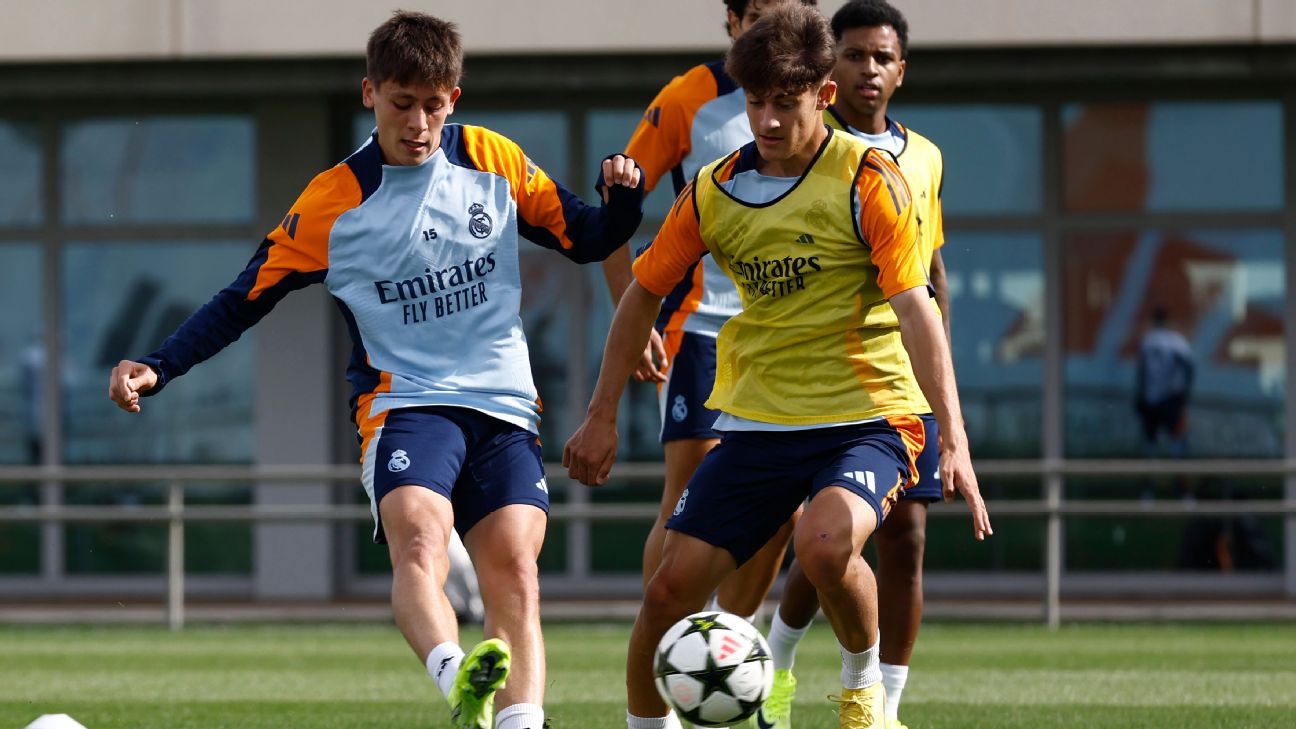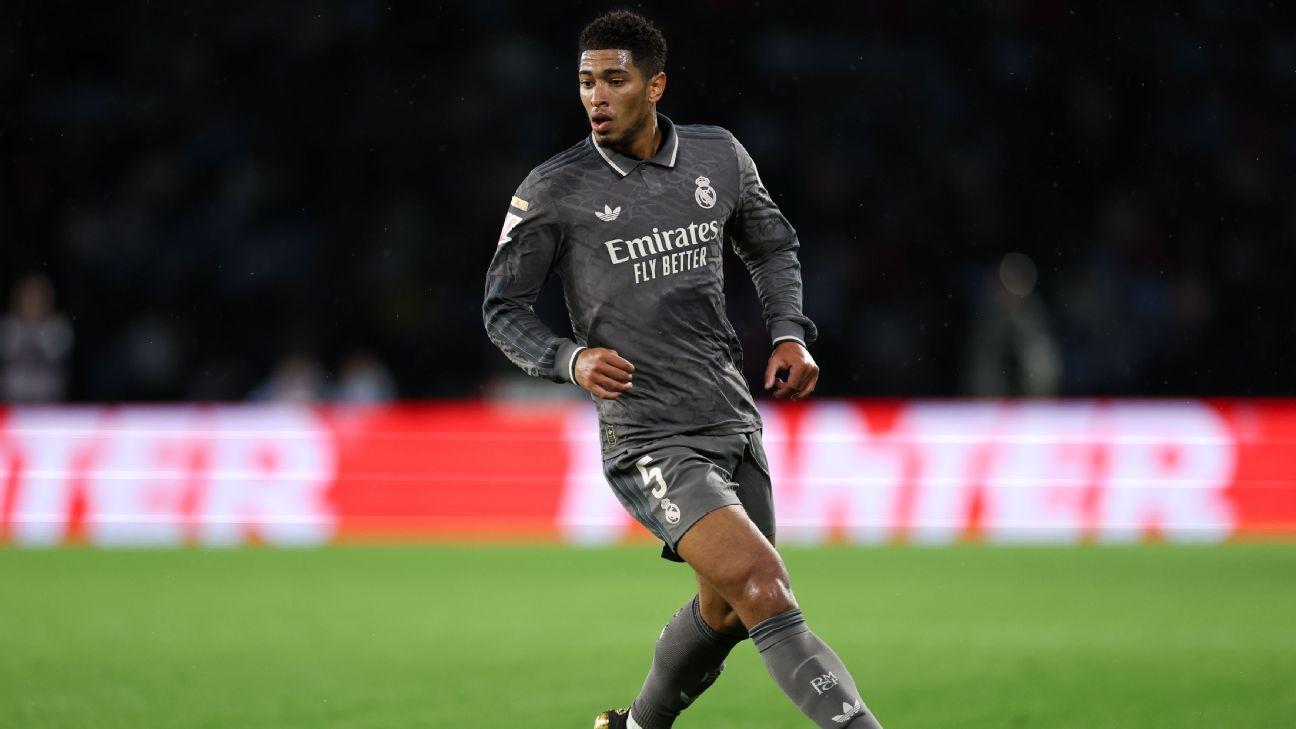Five games into the Premier League season and, in a sense, nothing has changed. Last season’s winner: Manchester City. This season’s leader: Manchester City.
Last season’s top four: City, Arsenal, Liverpool and Aston Villa. This season’s top four: City, Arsenal, Liverpool and Aston Villa.
While I don’t think you’d be wrong to plant your flag there — “City will win the league again, and the top four will remain unchanged” — five games is just enough games to be dangerous. It’s enough time to start to think what we’ve seen thus far will remain true for the rest of the season. But we know, from research, that it’s not until around the 10-game mark when what we’ve seen really starts to impact what we will see for the remainder of the campaign.
But that doesn’t mean we can’t dip our toes into those waters. So, let’s take a look at some of the trends that have emerged from the first month or so of the season, and assess whether they’re likely to continue.
 TRUE OR FALSE: Arsenal have learned how to win ugly
TRUE OR FALSE: Arsenal have learned how to win ugly
One of my favorite tautologies in soccer is when someone says “champions just find a way to win” after a theoretically great team has a bad game but ends up scoring a late goal to salvage a poor performance.
On the one hand, this is obviously true: Given the play-every-team-twice-and-no-playoffs structure of the Premier League, getting points from poor performances increases your odds of finishing higher in the table simply because you have more points. Champions find a way to win? Well, duh. Whoever has the most wins (or points) is going to be the champion.
On the other hand, this is obviously untrue: the more often you play poorly, the more likely you are to not get points. And the underlying nature of your performance is more predictive of your future performance than the result of a single match or two.
And so, we come to Arsenal.
The Gunners haven’t played a single dominant game yet. Not one of their matches in the Premier League or Champions League has produced an xG differential of plus-1 or more; Liverpool and City have combined for eight such games so far. In fact, Arsenal now have a negative expected-goal differential in the Premier League. At the same time, Arsenal haven’t lost a game yet, they just took points off City in a 2-2 draw at the Etihad, they won on the road vs. Tottenham in the North London derby, and they’re only two points back of first place.
Perhaps you’re now expecting me to say: “Well, this is clearly unsustainable, and Arsenal will come crashing back to earth.”
Not quite! Mikel Arteta’s side is harder to analyze than just about any team I can remember through six matches. Arsenal have been missing Declan Rice and Martin Ødegaard for chunks of the season already, and they’ve played large portions of two matches against two tough opponents, Brighton and Manchester City, down a man. Given all of that, 11 points is quite the haul.
So, I actually have no idea how good Arsenal are right now! The opener against Wolves at home was fine, then they really did play poorly on the road against Villa, and then Rice got sent off midway through the Brighton match. They played Tottenham without Rice and Ødegaard, they laid an egg against Atalanta on the road in the UCL, and then they went up 2-1 against City before Leandro Trossard was sent off right before halftime.
If we look at a blend of xG (70%) and goals (30%) and account only for time played at even strength, the league shakes out like this:
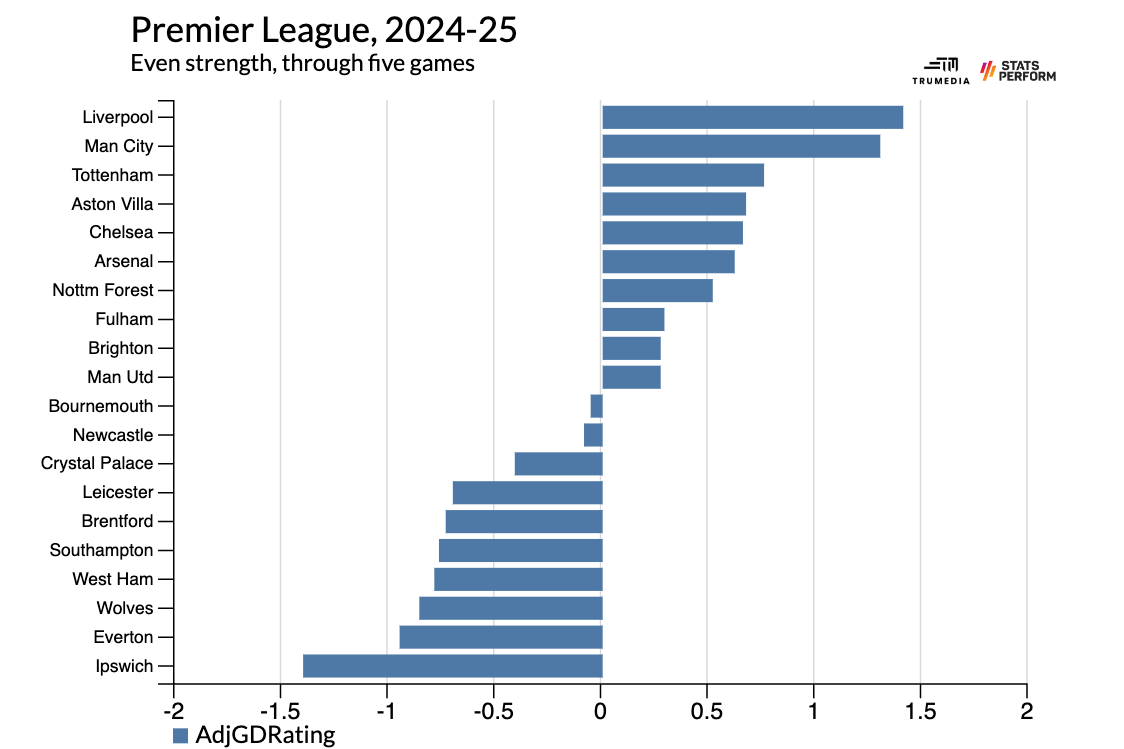 (Source: TruMedia)
(Source: TruMedia)
That’s cutting the season down to an even smaller sample of minutes, but maybe it’s helpful to think of it like this: at even strength, Arsenal were roughly even with City and Spurs, well ahead of Brighton, behind Villa, and better than Wolves.
It’s not that they have learned how to win while playing poorly. Rather, they’ve won more points than we’d expect from a combination of circumstances that include playing poorly, unlikely red cards and injuries to key players. If Arsenal go on to win the league, it will be because they weathered this tricky period and then kicked on and started dominating their opponents — not because of some kind of intrinsic quality that enables them to keep winning games when their opponents create better chances.
Verdict: False
 TRUE OR FALSE: Ryan Gravenberch is Liverpool’s long-term defensive midfielder
TRUE OR FALSE: Ryan Gravenberch is Liverpool’s long-term defensive midfielder
Liverpool have missed out on signing defensive midfielders Aurelien Tchouameni, Moisés Caicedo, Romeo Lavia and Martín Zubimendi over the past three summers — but you wouldn’t know it from the first five matches.
Without a player who, prior to the season, was considered a defensive midfielder, Liverpool have allowed one goal through five matches. And while they’re quite fortunate to have conceded only once, they still grade out as the best defensive team in the league by the blend of goals and xG that historically is a better representation of team quality than either stat on its own:
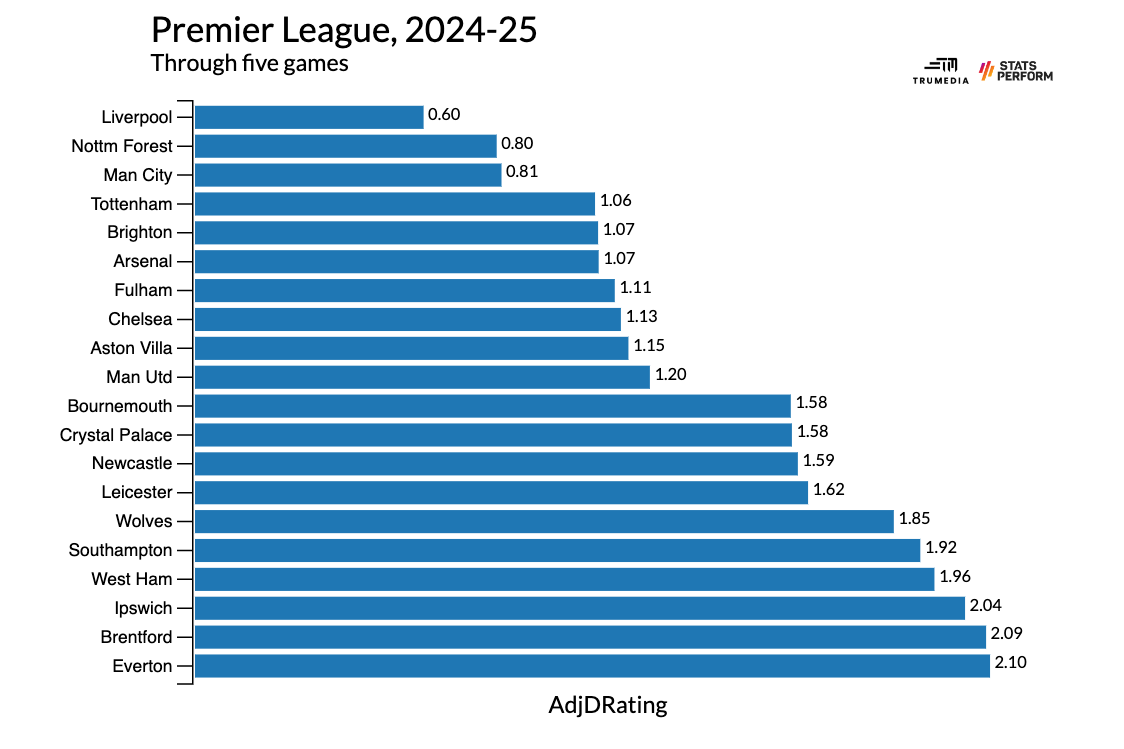 (Source: TruMedia)
(Source: TruMedia)
Five games in and Liverpool’s new defensive midfielder certainly looks the part. Gravenberch eats up ground off the ball. He leads all midfielders in ball recoveries, he leads Liverpool in combined tackles+interceptions and he ranks in the top 10 among all Premier League players in expected possession-value added — i.e. how much do all of your ball touches increase your team’s chances of scoring a goal. He really is doing it all so far.
It appears that Gravenberch is having a breakout season — and at an age, 22, when lots of players suddenly get a lot better. The only real caveat is the schedule: based on Opta’s power ratings, only Newcastle have played an easier schedule among Premier League teams. But Liverpool’s two toughest matches — away to Manchester United and away to AC Milan — have been Gravenberch’s two best games.
Given his soccer pedigree, his obvious physical and technical skills, and his lights-out performances so far, Gravenberch really could be Liverpool’s starting No. 6 for the next decade. The big question now: Can he handle the grind of the Champions League and Premier League for the next eight months?
Verdict: True
 TRUE OR FALSE: Jhon Durán is the next great Premier League striker
TRUE OR FALSE: Jhon Durán is the next great Premier League striker
Or, perhaps, he already is:
80 – Jhon Durán has now scored nine goals in 719 minutes in the Premier League; among players to have scored at least two goals in the competition, only Erling Haaland has a better mins/goal average (1 goal every 79 minutes). Unstoppable. pic.twitter.com/jziThITqOp
— OptaJoe (@OptaJoe) September 21, 2024
Duran has four goals for Villa through five Premier League matches, despite not starting a single one. If we extend it back to last season, the 20-year-old Colombia international has six goals in his past seven games. Villa, of course, already have one of the league’s best strikers in Ollie Watkins, but just imagine if Duran got more minutes. And he might, as manager Unai Emery recently suggested that Watkins and Duran could share the field more often.
But there are a couple of reasons to pump the brakes. The first: he has scored four goals from 10 shots. Put another way, that’s four from 1.66 xG:
 (Source: TruMedia)
(Source: TruMedia)
The second: it’s way easier to do this as a sub. Strikers score 44% more goals as subs than they do as starters, according to new research from Michael Caley. Apply that discount to Duran and he’s closer to two goals than four. And at this point in the season, two or three goals as a sub feels a lot different than four.
Despite all of that, Duran’s per-minute production is still absurd. He’s attempting 6.9 shots per 90 minutes, and he’s averaging 1.14 xG per 90. If we cancel out the finishing by using xG and then apply the 44% sub discount, that would bump Duran’s output down to something like 0.64 goals per 90. Given that he’s a striker and his left leg appears to have similar levels of power to light anti-aircraft artillery, we can push that up a little higher to, say, around 0.7 goals per 90.
We’re still extrapolating from a very small sample of minutes — one or two chances can greatly skew these numbers — but even adjusting for the context, Duran’s performance still looks quite good. Plus, he’s only 20! He’s very limited in possession still, and he’s getting to play in favorable contexts where Villa are chasing matches.
There’s still a ton of projection here — he has started three Premier League games in two years! — but Villa needed quality depth with the Champions League this season, and Duran has given them just that. It’ll take a much larger chunk of starter minutes and starter goals before we can call him a star, though.
Verdict: False
 TRUE OR FALSE: West Ham spent more money on transfers than Arsenal, Liverpool and Manchester City … and they got worse
TRUE OR FALSE: West Ham spent more money on transfers than Arsenal, Liverpool and Manchester City … and they got worse
By net spend — transfer fees out, compared to transfer fees in — West Ham were the fourth-most aggressive Premier League team this summer. They spent €100m more on transfer fees than they brought in. They were certainly backing new manager Julen Lopetegui, and it was the kind of summer that gets fans excited, encourages pundits to push them higher up the table in their predictions, and frequently is doomed to fail.
Two of West Ham’s biggest transfers — center-back Max Kilman from Wolves and striker Niclas Fullkrug from Borussia Dortmund — had massive red flags. The former is an ex-player of Lopetegui’s and the latter is 31 years old. And well: West Ham’s defense has been terrible, while Fullkrug is already injured.
Although he has had cup success, Lopetegui has pretty much no track record of improving any club he has worked for in any kind of sustainable way. (At Real Madrid, he lasted 10 LaLiga games, where they scored 14 goals and allowed 14 goals.) There are too many worse teams for West Ham to seriously flirt with relegation, but the team that finished ninth last season looks likely to finish somewhere in the bottom half of the table.
Verdict: True
ESPN’s Mark Donaldson and Janusz Michallik discuss Chelsea’s convincing 3-0 win over West Ham in the Premier League.
 TRUE OR FALSE: Nicolas Jackson is the next great Premier League striker
TRUE OR FALSE: Nicolas Jackson is the next great Premier League striker
Despite all of the consternation about his inefficiency in front of goal, Jackson finished his first Premier League season with 0.61 non-penalty goals+assists per 90 minutes. Or, a better rate than Bukayo Saka, Julián Álvarez and Luis Díaz. Of course, it could’ve been even better than that. His expected goals-and-assist rate was 0.74 — the ninth-best mark in the league.
Given that Jackson finished nearly five goals behind his expected number — and no one is consistently that bad of a finisher — Jackson’s underlying quality of play could’ve remained unchanged from last season to this season, and we still should’ve expected his output to improve.
Well, through five games, he has scored four and assisted two more, at a rate of 1.68 per 90 minutes. And those underlying numbers are even better, too: 1.02 xG and assists per 90.
Jackson was a prime candidate to make the leap this season, both because of his age (23) and what we know about the vagaries of kicking a ball into a goal. While it won’t continue to this degree, Jackson has improved his underlying performance and broken out of his finishing slump at the same time. That’s how you become a star.
Verdict: True
 TRUE OR FALSE: Nottingham Forest are one of the best defensive teams in the league
TRUE OR FALSE: Nottingham Forest are one of the best defensive teams in the league
I wasn’t buying it after their first three games, a relatively easy slate of matches against Bournemouth, Southampton and Wolves. But then they went away to Liverpool and Brighton — and conceded fewer than 1.0 xG in both matches.
Through five games, only Liverpool and City have conceded fewer xG than Forest. More impressively: Nuno Espirito Santo’s crew hasn’t allowed a single shot worth 0.33 xG or more. No one else in the league has allowed fewer than two:
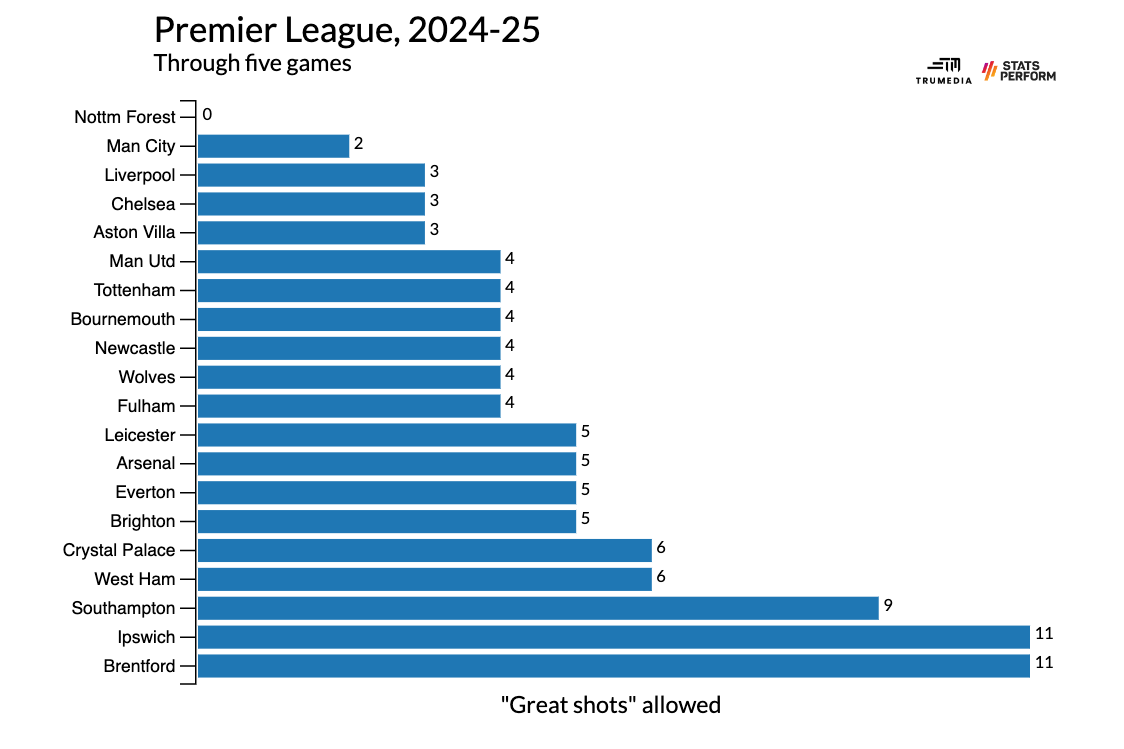 (Source: TruMedia)
(Source: TruMedia)
Forest came into the season as potential relegation candidates. Five games in, they already seem more likely to finish in the top 10 than in the bottom three.
Verdict: True

